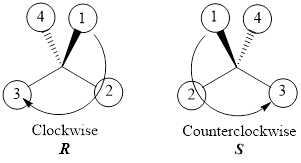
Concept explainers
Interpretation:
The configuration of stereocenters has to be determined and the enantiomer has to be drawn for the given compound.
Concept Introduction:
If a molecule contains a carbon atom that is bonded to four different groups, then that carbon is said to be chiral carbon and the carbon center responsible for this chirality is known as stereocenter. Stereocenter are located in a compound by looking into the atoms or groups that is attached to the carbon atoms. An example of a compound having chiral center is shown below,

The stereocenter can have either R or S configuration. This can be identified by numbering the groups from 1 to 4 that is attached to the stereocenter. If the stereocenter will be the same type of atoms attached to it, then the next atoms are considered. The way in which the numbering was given is based only on the

If the numbering goes clockwise, then the configuration will be “R” and if the numbering of the groups goes counterclockwise, then the configuration will be “S”. This can be represented as shown below,

The first and foremost condition is that the group with the least priority has to point away from us. If the group with least priority is not pointing away from us, then the group has to be switched in a way that the least priority group points away. By doing this the configuration of the stereocenter changes. After the switching is done and the group with least priority is pointing away from us, another switching has to be done with other groups so that the original configuration of the stereocenter is obtained.
Fischer projections are very much useful for drawing the molecules that contain more stereocenters. Fischer projections does not use wedge and dash bonds. Instead vertical and horizontal lines are used. Horizontal lines means they are pointing towards us and vertical lines means they are pointing away from us. Fischer projection can also be used for the compounds that contain only one stereocenter.
Enantiomers are the two compounds that are nonsuperimposable mirror images of each other. Enantiomers always come in pairs and they are mirror images of each other. If a compound is given with a chiral bond, the enantiomer of the same compound can be drawn by converting the stereobond alone. This means that all the dash bond has to be changed to wedge bond and wedge bond has to be changed into dash bond. Another method of drawing the enantiomer of the given compound that does not contain any wedge or dash bond is that to keep an imaginary mirror on the side of compound and draw the reflection that is got in the mirror.
Want to see the full answer?
Check out a sample textbook solution
Chapter 7 Solutions
Organic Chemistry As a Second Language: First Semester Topics
 ChemistryChemistryISBN:9781305957404Author:Steven S. Zumdahl, Susan A. Zumdahl, Donald J. DeCostePublisher:Cengage Learning
ChemistryChemistryISBN:9781305957404Author:Steven S. Zumdahl, Susan A. Zumdahl, Donald J. DeCostePublisher:Cengage Learning ChemistryChemistryISBN:9781259911156Author:Raymond Chang Dr., Jason Overby ProfessorPublisher:McGraw-Hill Education
ChemistryChemistryISBN:9781259911156Author:Raymond Chang Dr., Jason Overby ProfessorPublisher:McGraw-Hill Education Principles of Instrumental AnalysisChemistryISBN:9781305577213Author:Douglas A. Skoog, F. James Holler, Stanley R. CrouchPublisher:Cengage Learning
Principles of Instrumental AnalysisChemistryISBN:9781305577213Author:Douglas A. Skoog, F. James Holler, Stanley R. CrouchPublisher:Cengage Learning Organic ChemistryChemistryISBN:9780078021558Author:Janice Gorzynski Smith Dr.Publisher:McGraw-Hill Education
Organic ChemistryChemistryISBN:9780078021558Author:Janice Gorzynski Smith Dr.Publisher:McGraw-Hill Education Chemistry: Principles and ReactionsChemistryISBN:9781305079373Author:William L. Masterton, Cecile N. HurleyPublisher:Cengage Learning
Chemistry: Principles and ReactionsChemistryISBN:9781305079373Author:William L. Masterton, Cecile N. HurleyPublisher:Cengage Learning Elementary Principles of Chemical Processes, Bind...ChemistryISBN:9781118431221Author:Richard M. Felder, Ronald W. Rousseau, Lisa G. BullardPublisher:WILEY
Elementary Principles of Chemical Processes, Bind...ChemistryISBN:9781118431221Author:Richard M. Felder, Ronald W. Rousseau, Lisa G. BullardPublisher:WILEY





